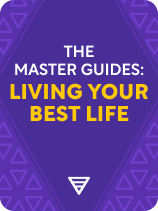

This article is an excerpt from the Shortform book guide to "The Master Guides: Living Your Best Life" by Shortform. Shortform has the world's best summaries and analyses of books you should be reading.
Like this article? Sign up for a free trial here.
Do you feel unaligned with your values? How can you find worthy values to live by?
A crucial part of feeling happier is determining what your values are. To achieve this, you need to take three steps: accept yourself as you are, assess your current beliefs and values, and identify gratifying experiences.
Keep reading to learn how to find your values that fit your standards.
1) Accept Yourself
The first step toward learning how to find your values is to let go of your need to seek external validation. Neil Pasricha (The Happiness Equation) suggests that you can free yourself from the need for validation by accepting who you are and what you need to feel happy. This shift in thinking encourages a cycle of happiness and satisfaction: Self-acceptance inspires you to align your behaviors and decisions with what makes you happy. This alignment encourages positive self-judgment and influences you to make decisions that further increase your happiness.
Furthermore, the more you encourage positive self-judgment, the less time you waste thinking about how others perceive you. This helps you accept yourself exactly as you are and frees you from the pressure of adapting to please or impress others.
2) Assess Your Current Opinions and Beliefs
An important part of accepting yourself and clarifying what you want out of life is assessing whether your current opinions and beliefs align with who you really are or if they only exist to please or impress others. Brianna Wiest (The Mountain Is You) suggests that you can dissect each of your opinions and beliefs by asking yourself the following four questions:
- When was the first time you came across this idea? For example, you believe that people should not make mistakes. You remember overhearing your parents punishing one of your siblings for making errors on a spelling test.
- How does this idea influence your judgment of yourself, other people, and your experiences? Your belief that people should not make mistakes compels you to be overly critical of yourself and others. It also makes you feel resentful of the experiences that don’t live up to your perfect standards.
- How might adopting opposing ideas impact you? If instead, you choose to believe that it’s okay to make mistakes, you might find it easier to accept and forgive yourself and others for making mistakes. You might also be less inclined to notice mistakes in the first place.
- How would you choose to think about this if your thoughts were already aligned with who you really are? Your aligned self sees mistakes as a valuable part of learning. Therefore, there’s no need to feel critical of yourself or others for making mistakes.
Distinguish Between Positive and Negative Values
Beyond assessing whether your values are truly yours or if they’re informed by others, think about whether your current values are “positive” or “negative.”
According to Jay Shetty (Think Like a Monk), values that inspire positive thoughts, such as compassion or kindness, are true values that elevate you to a state of happiness, fulfillment, and meaning. On the other hand, values that inspire negative thoughts, such as fear, greed, or envy, are false values that demote you to a state of suffering, dissatisfaction, and anxiety.
Mark Manson (The Subtle Art of Not Giving a F*ck) considers the difference between positive and negative values a bit differently:
- Positive values arise from an internal focus and have outcomes that you can control. For example, if you adopt kindness as a value, you can shape your thoughts and behaviors to align with this value.
- On the other hand, negative values arise from an external focus and have outcomes that you can’t control. For example, if you adopt popularity as a value, the outcome hinges on what others think about you. While you can adapt your behavior to increase your popularity, you’ll never be able to control the outcome.
3) Define Your Values
You’ve now determined which beliefs serve you and which don’t, and you’re closer to understanding who you really are. Now, let’s explore what’s important to your true self in order to define your values and clarify what you really want out of life.
Approach 1: Pay Attention to What Satisfies You
Bill Burnett and Dave Evans (Designing Your Life) suggest that the key to defining your values lies in paying attention to what satisfies you. They recommend that you start a daily journal to track and reflect on how your activities make you feel. The point of this is to identify what types of experiences make you feel joyful, engaged, and energized—and those that make you feel bored and drained.
After the first week of tracking, include weekly reflections in your journal: Zoom in on the details of each activity to identify what you specifically like or dislike about them. Pay particular attention to who you were with, what you were doing, where you were, and what you were interacting with (for example, people, objects, or a machine) as your positive feelings rose and fell. Write down any themes, insights, or surprises you discover. If your current schedule doesn’t offer much in the way of variety, consider including reflections on past experiences that stand out as particularly positive or negative.
Jack Canfield (The Success Principles) adds to this by suggesting that you list the times in your life that you’ve felt most happy and determine whether these instances share any characteristics.
Approach 2: Brainstorm Your Ideal Life
Canfield suggests that brainstorming what areas of your life are important to you and what you want them to look like will help you define your values. For example, what kind of relationships do you want, and what characteristics should they include? You can consider other areas like finances, leisure, or community as well. Then, write down 30 things you want to be, 30 things you want to have, and 30 things you want to do before you die.
Meanwhile, Burnett and Evans offer a way to brainstorm values that help you achieve the perfect work-life balance. There are three parts:
- Write down your opinions on work. This includes everything you believe about work: what it’s for, why you do it, and what makes it good or bad.
- Write down your opinions on life. This includes everything you believe about the world and how it works: what it means, what gives it value, how your life relates to others, the place of money in a meaningful life, and the value you place on fulfillment and experience. (You might draw inspiration from Canfield’s brainstorming exercise here.)
- Consider how to integrate your values in both areas so they’re in harmony with each other.
Approach 3: Meditate With Your Ideal Self
In The Mountain Is You, Wiest suggests that you can define your values by engaging in meditation with your ideal self. First, find a quiet place, sit down with a pen and paper, take deep breaths to center yourself, and release any fears or negative emotions. When you feel totally relaxed, visualize the highest version of yourself sitting across from you. Then, take note of how they look, behave, speak, and communicate through their body language; what are they wearing, how are they feeling, and what do they do every day?
Next, listen to the advice that this ideal self wants to give you, even if it’s something you might disagree with at first. This advice should be uplifting, caring, and helpful. Now, imagine the particular aspects of this person’s life that allow them to live their values—where they’re living, what job they’re doing, the relationships they have, their daily tasks, their habits, and so on. Finally, imagine them giving you the key to that life—their life, routines, behaviors, and skills are now yours. This final step will put you in an “action” mindset that encourages you to enact the tasks and behaviors necessary to become your ideal self.
In addition to considering your ideal self’s qualities, Shetty recommends that you think about the qualities that you look for and admire in others to reveal the values that inspire you.

———End of Preview———
Like what you just read? Read the rest of the world's best book summary and analysis of Shortform's "The Master Guides: Living Your Best Life" at Shortform.
Here's what you'll find in our full The Master Guides: Living Your Best Life summary:
- Over a dozen experts' advice on living your best life
- How to understand what's making you feel unhappy
- Actionable steps for living a more meaningful and happy life






